Vamos Rogelio!
A love story
Leland de la Durantaye
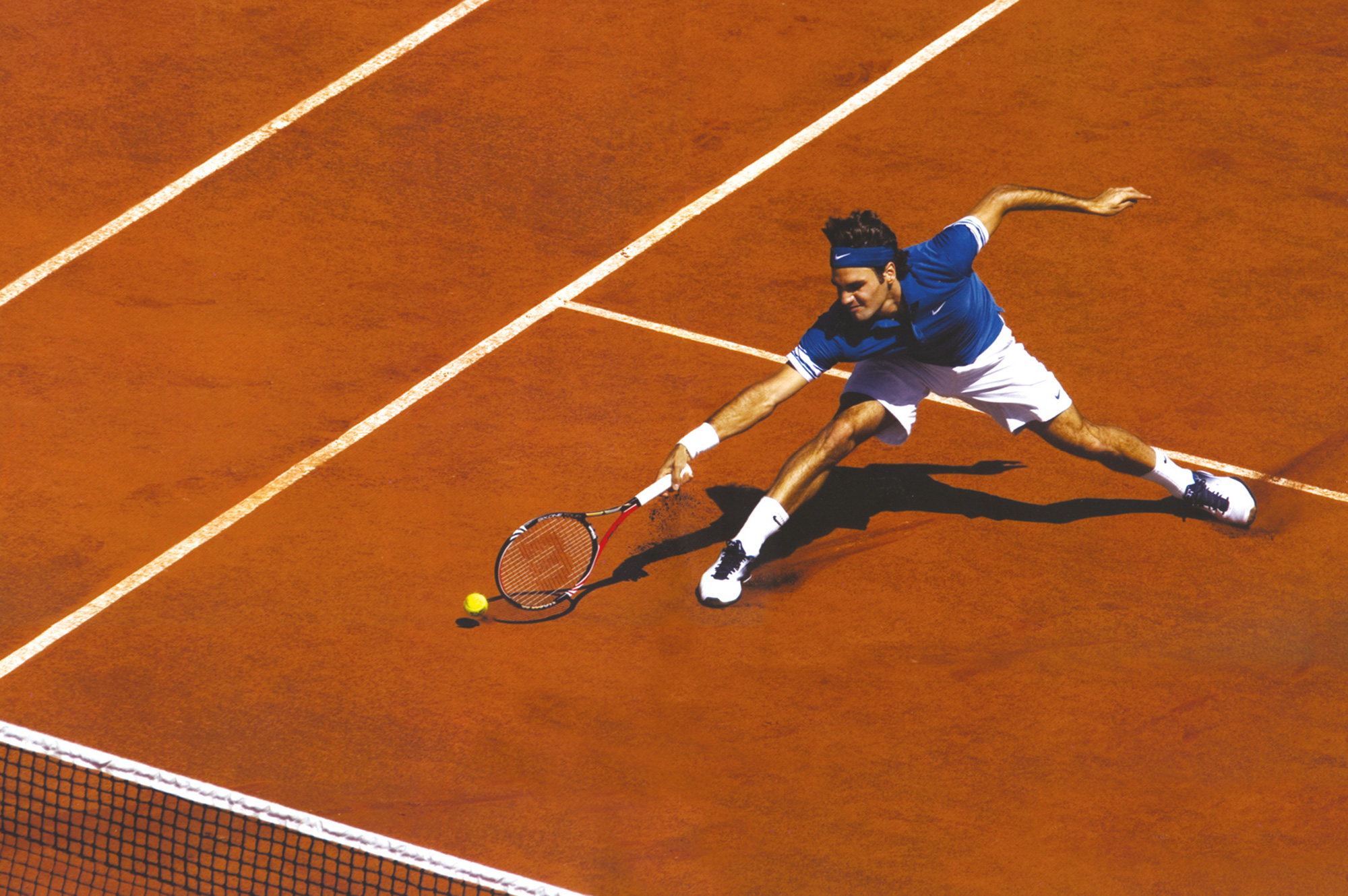
I was once given charge of the exceptionally amusing children of some friends and, not knowing what to do with them, took them to Kids’ Day at the US Open. I was bored because the kid stuff was boring, even though the kids were not, and so was leading my little troop off the grounds in search of better adventure in greater Queens when it began. Two children ran by us, slipped through a gate, and disappeared. After a quick consultation and some running, we emerged courtside in a stadium empty save for a handful of spectators, none over ten years old, watching the inconceivable. But I should begin at the beginning.
• • •
Ball games in the Americas began as sun-worshipping rites. The ball represented the sun and there were fatalities. Fast forward to March 2014 in the Mojave Desert, where the fifth-most-important tennis tournament in the world is played. Even in early spring, the sun there is like anger and the heat like punishment. The Santa Rosa mountains, which loom over Indian Wells and separate it from Joshua Tree Park, seem to say, in a constant whisper: no water. The only shade for miles around is that of the main stadium of the BNP Paribas Open, the second-largest tennis stadium in the world.
During the women’s final, I had left the grounds through the players’ exit. So that my dog—thick-coated, born for snow—might survive the afternoon, I had found a tiny plot of shade. Having just checked the dog’s vital signs and received a look which was perfectly translatable into human as You must be fucking kidding, I was returning through the cool, shady area reserved for players, press, and tournament officials when it happened.
The area was empty, which was strange considering what a bustling place it had been for the preceding weeks. Notwithstanding the remoteness of the tournament’s location (the nearest city of note, Los Angeles, is more than two hours away), there were always a great many people wanting autographs and attention, and so this protected refuge was the only part of the extensive tournament grounds where players could be at anything approaching ease. Ten days earlier, at the table where I was pausing to eat a hasty lunch, I had less interviewed than just really annoyed Richard Gasquet, a Frenchman then ranked twelfth in the world and best known outside the tennis world—and, come to think of it, inside it as well—for having tested positive for cocaine, and then successfully appealing the finding with the claim that the cocaine entered his system orally, and involuntarily. This was because—get ready for the French part—he met a girl in a club and they were dancing and they were kissing and how could he know that she had just been doing a cartel level of cocaine and so it was in and around her mouth? How, indeed? responded tennis’s governing body, the Association of Tennis Professionals, an organization with a surprisingly liberal attitude concerning the realities of being a pro tennis player. (The stories about Vitas Gerulaitis, Ilie Nastase, John McEnroe, Jimmy Connors, and that generation’s wild partying, frequently involving Andy Warhol and Studio 54 during the US Open, support such a conclusion.) Around Gasquet on that first day sat much of the French delegation in the tournament, including the acrobatic Gael Monfils, the senatorial Paul-Henri Mathieu, the spry Gilles Simon, and the highest-ranked of the French, Jo-Wilfried Tsonga, the ninth seed and the only one of them with what bookmakers considered a legitimate chance of winning the tournament. (He lost in the first round.)
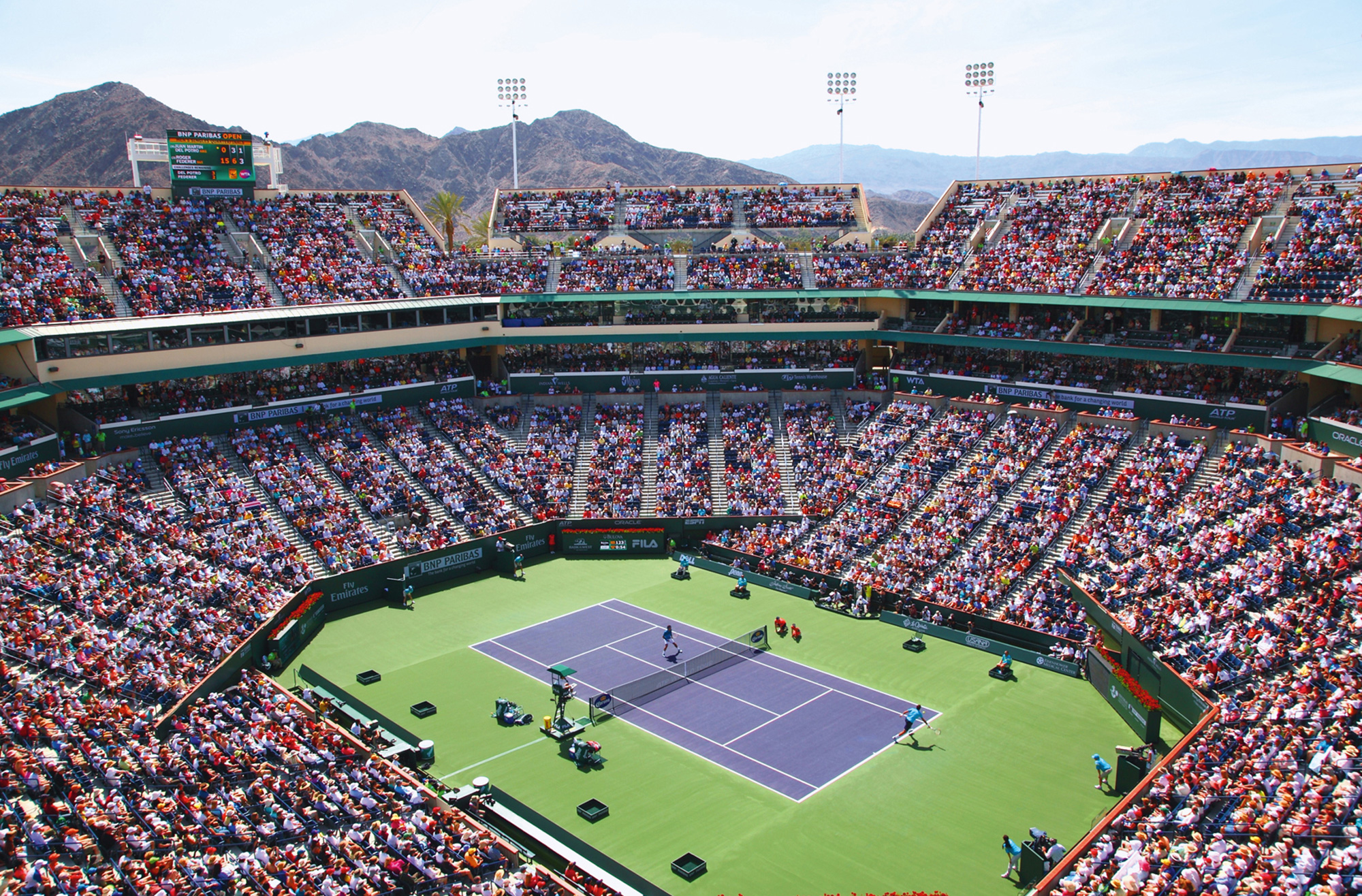
Where I sat had been bustling on that day and all the days of the tournament because it offered not only shelter from sun and fans but was where food and drink were to be had, things that professional tennis players consume in supernatural quantities. John Isner, who would make it to the semi-finals, lost nine pounds during a two-hour practice, and while that is above average, losing four or five pounds during a match in desert heat of this sort is not unusual. Although generally sparing in professional detail, Andre Agassi’s Open, the best tennis biography, dedicates significant attention to the complicated electrolyte combinations his trainer concocted to induce Agassi’s body to absorb as much water as possible before match time, for acute dehydration is not pretty. Its nadir is total body cramping, which is just as terrible as it sounds. It is usually preceded, like death in the Himalayas, by euphoria, as though your body wanted to break it to you gently that it was about to terminate services. But by this point, no one was preparing a special pasta for commentators like John McEnroe or a special drink for players like Serena Williams. The women’s final had just ended and the men’s was about to begin. I heard Rihanna sing “we found love in a hopeless place” over the stadium’s loudspeakers—from a song which the organizers had been playing before all of Federer’s matches.
As I made to leave, a group entered the shady area from the locker room. In their midst a little girl demanded her father. A tall man bent down, hands on knees, and told her she would have to wait because “daddy has to run around for awhile.” This piece of information was supplied to the four-year-old daughter of Roger Federer. Federer’s entourage is reclusive, which made this like seeing a condor not just far away, but having it land on your hood ornament. Not a great simile, no, but it was very hot and this was not an easily comparable situation. Another, and deeper, source of wonder came, however, from the wisdom of the words. These were issued by Gavin Rossdale, semi-rock star and husband of Gwen Stefani (total rock star). For a great many in the tennis world, however, Rossdale is best known not as a musician but as a Friend of Federer, attested to by his presence in Federer’s box during the greatest, and most watched, tennis match in history: the 2008 Wimbledon men’s final, when Rafael Nadal beat Roger Federer 6–4, 6–4, 6–7 (5–7), 6–7 (8–10), 9–7. If your eyes just skipped lightly over that score, that is in the nature of things. But know that for those who lived through it, the score is like Mahler, complete with weeping. As Brian Philips wrote: “There’s Psalms 137:9, and then there’s Wimbledon 6–4, 6–4, 6–7 (5–7), 6–7 (8–10), 9–7.” (Psalms 137:9: “Happy shall he be, that taketh and dasheth thy little ones against the stones.”) This match lasted almost five hours and its final three sets, with Rossdale and everyone around him mesmerized and Nadal’s fans frantically crying “Vamos Rafa!” between every point, involved play of a level that was nothing short of staggering and left anyone who cared about its outcome, or about tennis, or about the human condition, utterly drained. Federer cried at the end. Nadal cried. Björn Borg, in attendance, appears to have cried. I cry still, so I recognized Rossdale straightaway.
Federer’s daughter, with the gravitas of very small children, thought for a moment about her father needing to run around for awhile, and then with the good judgment so characteristic of both her parents (her mother, Mirka, is a former pro) accepted this explanation and skipped off to join six-year-old Zuma Rossdale. Running around for awhile is, after all, something that people of all ages understand because it is something that people of all ages need to do. It calms us and, ideally, makes us better suited for more constructive activities (this was clearly the hope for Zuma, who was at that moment, to the wonderment of his nanny, giving himself a wedgie). But as both of Federer’s daughters were beginning to learn, every single time their father wants to run around for awhile, throngs of people will wait in the blistering heat or in great and prolonged boredom for the chance to watch, after which they beg for his sweatbands and for him to sign giant tennis balls or to help them in some way understand what they have just seen. For he is different.
• • •
The inconceivable thing on that August afternoon in New York in 2009 that the children and I saw was Roger Federer running around for awhile. Kids’ Day takes place on the last day before the tournament begins, and a number of top players were getting in some final practice sets on the main stadium courts. These were meant to be off-limits to the public, but someone apparently forgot to lock the gates. Many of the top pros were there and although they didn’t want to exhaust themselves, they did need to fire up their engines to something approaching full throttle. There was tournament-level tension as, for instance, when Andy Roddick was leaving the court and Andy Murray entering it. Unlike them, neither Federer nor his practice partner Tim Henman had brought a coach—Henman because he was about to retire, and Federer because he did not have one, and hadn’t had one in years. This was unheard of in modern tennis, where coaching plays a huge role—so much so that the reason Murray and Roddick were so tense with one another was that Murray’s then-coach, Brad Gilbert, author of the best-selling Winning Ugly, had been Roddick’s coach until having been fired, and then promptly hired by Murray. What was inconceivable was not this psychodrama, however, or even the unorthodox success of my babysitting, but what Federer did.
The first swing he took looked like a joke, so long and hard that it had to be uncontrollable, and when he hit the ball cleanly it seemed the most amazing fluke, until a half-second later he did the same thing, and continued to do so for over an hour, hitting very long, very fluid, very hard, and unbelievably precise strokes with the only difference being that as he got looser the strokes got still longer, the timing more exact, the selection of shot more surprising, the arsenal wider, and the weapons sharper. I said, softly but repeatedly, “Fucked up,” even after having been shushed by the children. When children ask you to stop swearing it is a pretty clear sign that it has become excessive, and yet what else was I to do? For what I saw was fucked up. I had spent thousands of hours on tennis courts, played on teams with players who went on to be pros, one of them a US Open Finalist, and had generally seen an exceptional amount of high-level tennis, starting when I was the age of these children. But I had never seen anything like this.
Federer exercised an animal fascination over the children, and myself, that was different from that of Roddick or Murray or the others. This may have had something to do with fame, but many were too young for that. Like most great athletes, like Jordan, Kobe, Zidane, Messi, lions, etc., Federer is more fluid than those around him. His body and being appear to be extremely relaxed until the moment of movement, which is fast, smooth and has something lethal about it. What makes him so unreadable a player (he is famously difficult to anticipate) is this very relaxation, for it is tension that opponents can learn to read, whereas relaxation is illegible. No one arrives so perfectly on time for his meeting with the ball as Federer, not only never too late, but never too early, so that all the momentum of his arrival flows into the shot with what appears to be almost effortless violence. Most professionals do this approximately, often with lots of fine-tuning little steps at the last minute (right before impact, Nadal, for instance, takes a series of hunched mini-steps). Federer does it so exactly that his strides are long, which is only possible thanks to the unearthly sense he obviously has of where his body is in relation to everything, always. No player has ever hit so many jaw-droppingly amazing shots because his constant sense of where his body is allows for a high level of creativity. He plays as Hannibal, Caesar, and Napoleon are reported to have fought: trusting that his own speed of mind and movement will always be greater and so accelerating the conflict in an improvisational manner, creating ever more complicated, more deceptive, more dangerous, and more aggressive angles of play until his opponent is, as a rule, overwhelmed.
• • •
After leaving Federer’s entourage, I took my seat as the two finalists were getting ready to run around. Behind me were two Mexican men, both of whom called out Vamos Rogelio! Even though he does not even seem to notice the crowd when on court, Federer routinely has it behind him. This is largely because we are creatures sensitive to beauty. We always want more of it. Another reason why we—the children, the Mexican men, myself—were so much more fascinated by him than by the other astounding athletes at the top of the game, may be found in our shared past, our very, very, very distant shared past: that of hunting. To be a mammal is to be mimetic, to learn by imitation, mental and physical. As we began to be who we now are (humans who can have sun-worshipping games with fatalities and complex capitalist ventures such as the BNP Paribas Open), we imitated in mind and body the movements of the best hunters, and of the animals they hunted, learning to move in our minds with their movements, to roll and leap and start as they did, our mirror cells alight, learning movement intuitively, over millennia, by watching.
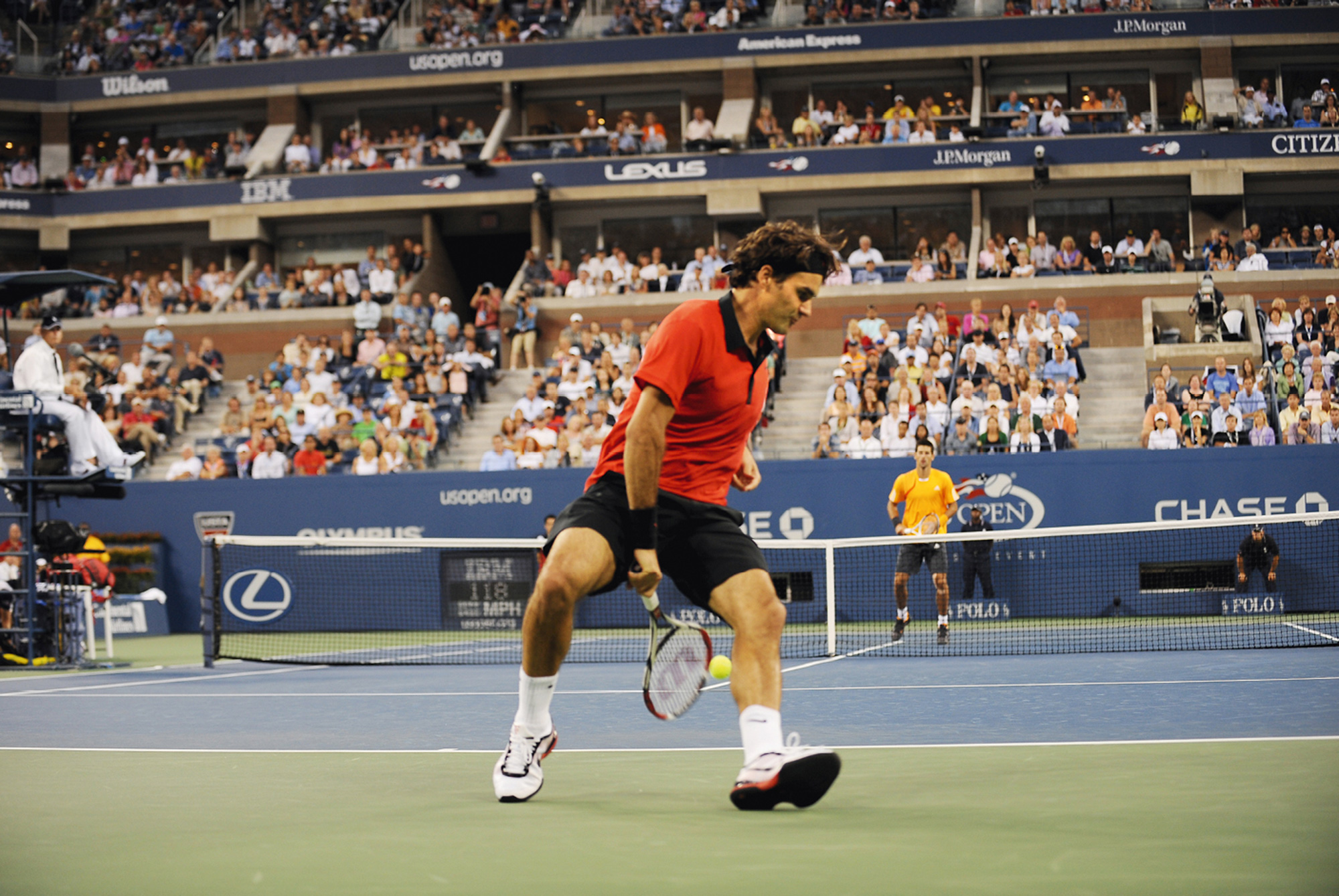
The first point of the final went to Novak Djokovic as Federer dumped an easy backhand into the net. I felt fear. The next point was an aggressive exchange, with steadily widening angles and sharper use of spin, ending with a vicious Federer winner. The fourth point of the match offered a still more dramatic exchange, a crescendo of force culminating with Federer hitting a museum-quality down-the-line backhand so unfathomably difficult and hit with such ease and grace that everyone in the stadium gasped a bit. Everyone but Djokovic. He was the only way he could be about this: philosophical. He does not appear to be a particularly philosophical guy: he literally tears his shirt open and flexes to the crowd after victories. But he has seen a lot of shocking things come off of Federer’s racket, including the most viewed shot in tennis history, a between-the-legs ground stroke hit screamingly hard and with Federer’s back to Djokovic at the moment of impact to set up match point in the semifinals of the 2009 US Open. Djokovic has seen so much unearthly geometry come off of Federer’s racket that he no longer seems affected by it. The reason he can be this way is that he has learned a crucial fact. The effect of Federer’s aging (Federer will soon be 34, which is very old in tennis years, and has four kids) is not sudden and complete loss of brilliance, but its periodic interruption. He has learned to see Federer playing great not as the steady state it once was, but as something like a storm he needs to weather, and which will be followed, sooner or later, by clearer skies. As on this day.
After the end of the first game, which Federer wins, I don’t clap, but not because I am impartial. The press corps does not clap and although I may not be respecting seating regulations, I respect this. But inside I am screaming “Vamos Rogelio!” I can feel very clearly that not only do I want Federer to win the match, I want him to win every single point. I appear to have no control over this fact. As Djokovic prepares to serve, my notes include the observation: “no emotional safety.” During the changeover, I recall the loss of reason during an earlier match between Djokovic and Federer, one I watched in an empty pizzeria in Cambridge, Massachusetts; as I stared out the back window of the pizzeria at the tombs of Cambridge’s founders and as Federer missed shot after shot, I slammed my hands against the bar and asked myself for what had those men and women died if not the very principles incarnated in Federer’s game? In other words: no emotional safety, minimal use of reason. Djokovic to serve.
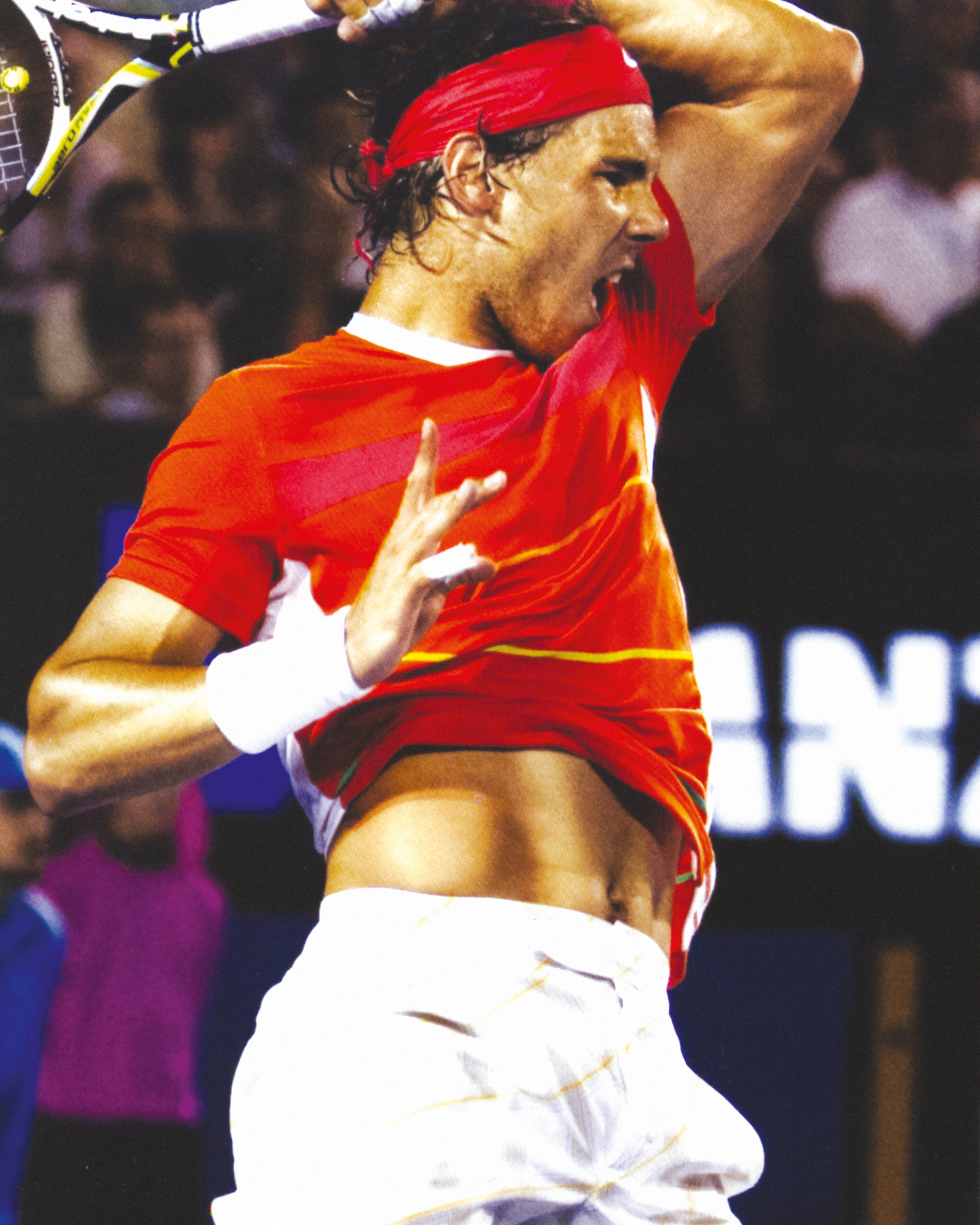
Although on this day Djokovic will hurt me, as he did on that Cambridge afternoon, it is not he who has made me suffer most. Far from it. For every fan of Federer, from Rossdale to David Foster Wallace, suffering’s name has always been Rafael Nadal. There is a very broad consensus (which includes both Nadal and his coach) that Federer is the greatest player ever, which is reflected not only in how mesmerizing he is to watch run around but in all sorts of numerical indicators (most weeks at number one, most Grand Slam titles, most prize money, etc.). And yet Nadal routinely beats him, leading their head-to-head matchups 23–10, well into “owning” territory. (The head-to-head was closer when Federer was still in his physical prime; Nadal is a little more than five years younger.) Another factor is the surface on which the matches were played, as, for years, Federer was better on Nadal’s best surface—clay—than Nadal was on Federer’s best surface—grass—and so a disproportionate number of Nadal’s victories are on clay. And yet the greatest match ever played, with Rossdale and everyone else watching, was played on Federer’s best surface, grass, and saw Nadal prevail. Here is why.
If you were a demon and had to intelligently design an opponent in every way disadvantageous for Federer, you would quite simply make Nadal. Nadal is, and always has been, coached by his very engaging uncle Toni Nadal, who has repeatedly said that Federer is the best tennis player in history, but that his nephew can beat him. Uncle Toni has had a lot to do with this, as, it appears, has the rest of the closely knit and exceptionally athletic Nadal family (another of Nadal’s uncles, Miguel, played soccer for FC Barcelona and was on three Spanish World Cup teams). Toni trained his nephew with old balls on bad courts, and went so far as to tamper with his rackets to impart to him, at the deepest level, the conviction that winning is only and ever about will and footwork. His coaching philosophy seems to consist largely in telling his nephew to play every single point as though it were his last. Which—amazingly—Nadal does. This is, in tennis terms, moral purity. No player in the history of tennis has ever so completely played in defiance of score, such that it is impossible to tell when shown a point in isolation whether Nadal is up two sets and a break, or is in a fifth-set tiebreaker facing five consecutive match points.
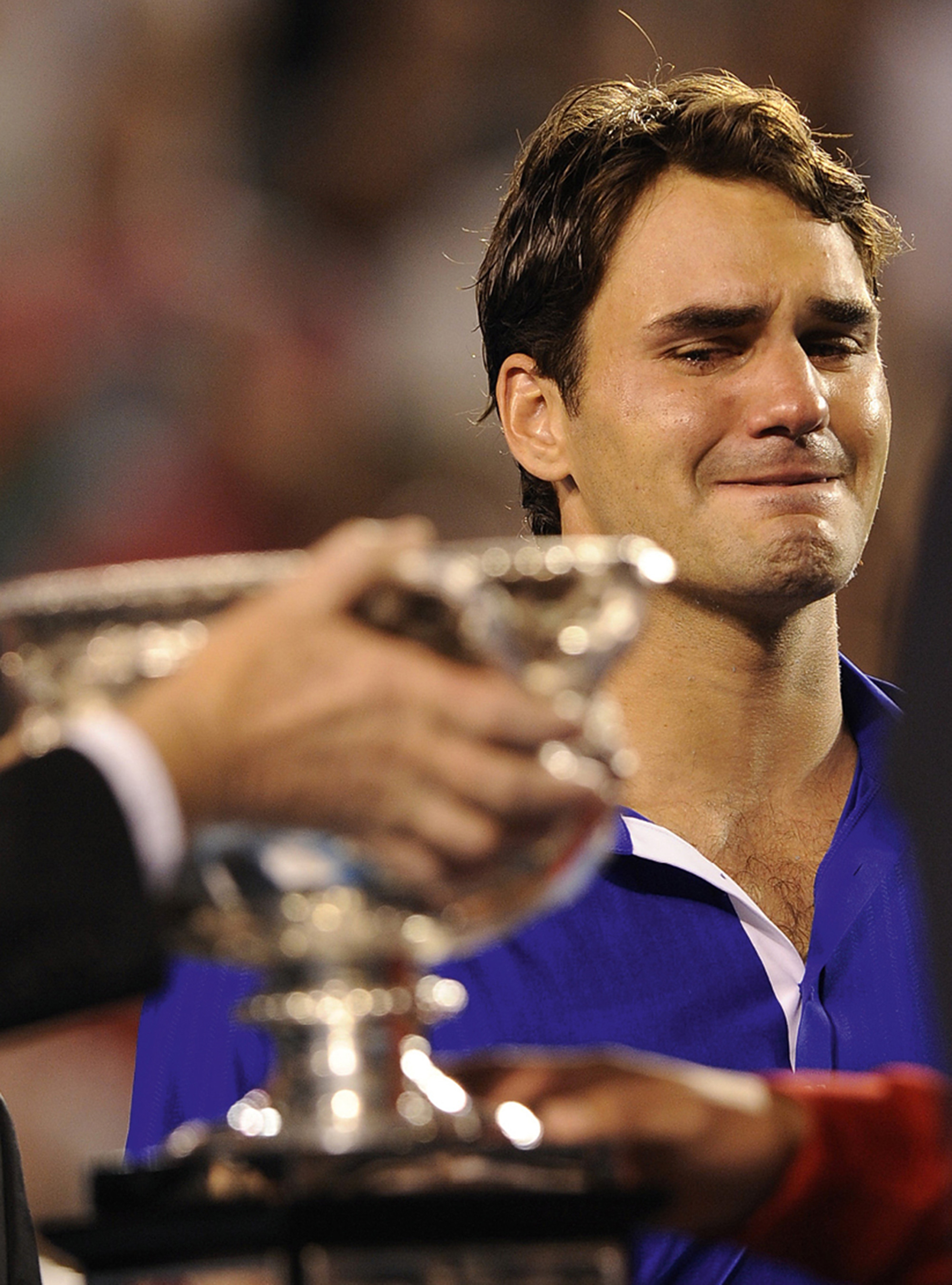
But Uncle Toni also did something else. Nadal is essentially right-handed (he writes, for instance, with his right hand), but he belongs to the small percentage of the world’s population who are, for all intents and purposes, ambidextrous. So Toni taught his nephew to play tennis as a left-hander. Left-handers have a natural advantage in tennis (and in combat) stemming from their rarity. In tennis, as in all sports, they are thus disproportionately represented. But the estranging effect of Nadal’s left-handed advantage is redoubled by the fact that he does not play like other left-handers, and his spins are not like a typical left-hander’s. A normal left-hander with a two-handed backhand would have his weak arm behind. Nadal has his strong arm behind and so his backhand has nothing of the defensiveness associated with the prefix back. His forehand is, if anything, still more unusual, as the trajectory his swing traces does not go across his torso, as almost all forehands ever have done, but swerves around his torso, ending on the same side of the body where it started—a motion that does not look like anything else, although it is often compared to the use of a bullwhip. As has been scientifically observed, Nadal hits tennis balls with more force than any other player, and yet they do not travel through space with exceptional speed. Federer, for instance, hits, on average, harder. Spin is safety in tennis, and topspin, its most common form, is conservatism in flight, allowing the ball to clear the net by a comfortable margin, and yet with enough rotation for it to be pulled back down to earth well before the baseline. By that same virtue, it can create new angles and very challenging geometry. But Nadal’s shots don’t just do this, they kick like mules—every single one of them. They thus take a huge amount of force to control.
This poses significant problems for everyone, but less grave ones for fundamentally defensive players such as Djokovic and Murray than for fundamentally offensive ones like Federer. (Federer is among the most essentially attacking players in the history of the game.) Federer must control these balls, which are not only in general hard to attack but are perfectly calculated, and even partly developed, to press viciously upon Federer’s Achilles heel: high one-handed backhands. Federer has one of the best one-handed backhands ever. But one-handed backhands evolved for a different world than one dominated by poly-fiber string in carbon-fiber frames, and high backhands are, for basic anatomical reasons, much harder to hit for players with one-handed backhands. Given Federer’s height, six foot one, Nadal’s forehands kick right into his anatomical weak zone in a unique way.
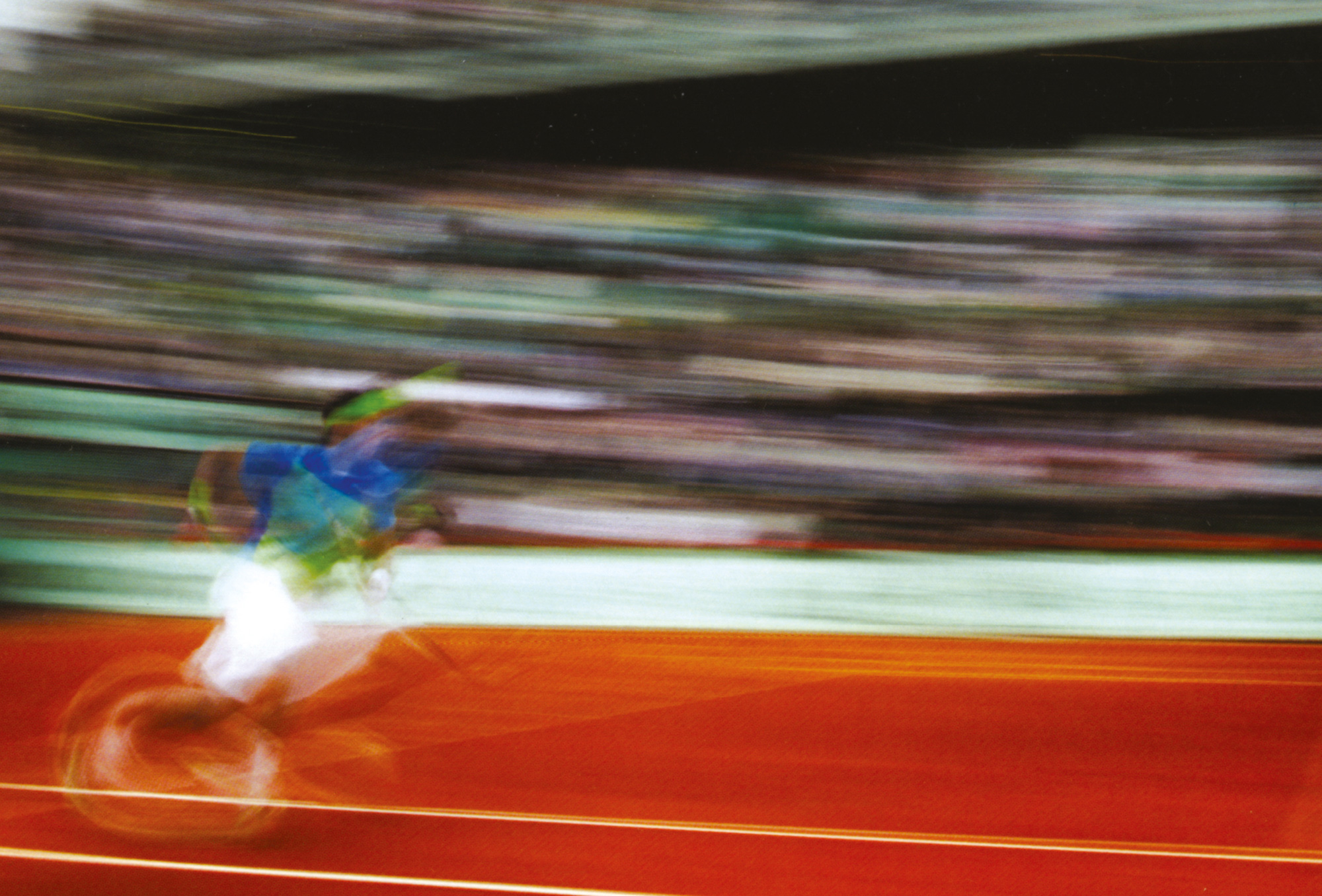
That explanation does nothing to minimize Nadal’s achievement, for this structural advantage merely blunts Federer’s attack, and to beat Federer, Nadal must also defend heroically, tirelessly, under a full and varying onslaught, for many hours, which he almost always does, with great dignity and resolve and sheer will. By every human standard, Federer is amazing under pressure. For all of the last three sets of that 2008 Wimbledon he was only ever a few points away from defeat. The winner he hit on Nadal’s championship point in the fourth set tiebreaker is found in every anthology of great points under pressure. In the following year’s Wimbledon final, Federer defeated Roddick 5–7, 7–6, 7–6, 3–6, 16–14, which, as the sheer number of those numbers underlines, took steady nerves. He has reserves of calm and faith in himself about which most can only dream. He is no pushover. And yet, Nadal, sooner or later, pushes him over. For there is an additional factor.
Off-court, Nadal is calm, patient, amiable, and respectful. On-court, he literally seems like another person. It is not that he becomes aggressive, petty, mean, or unfair. It is far stranger than that. The following is going to sound a little negative at first, and a little critical, but it is neither. Everyone changes under pressure and everyone behaves differently under it. But the gulf between off- and on-court is great in Nadal. This is so intensely the case that his own mother finds it nearly impossible to watch him, not for fear that her son might lose (which is very rare), but because she does not, in her words, “recognize” him. This is not surprising in the slightest. To begin with, when he emerges on-court for a match he seems in the throes of a fearsome restlessness. During the coin toss, he cannot stand still for a moment and even four hours into a match he will, when made to sit during changeovers, drum his feet impatiently. He seems, in this respect, to be moving on a different timescale than those around him, which makes his unbelievable powers of anticipation and his equally unbelievable speed make a sort of sense.
He is not, however, confrontational, and does not, as McEnroe so often would do, seek the gaze of his opponent. He is interacting with something within. And that thing within demands much of him. The precision with which he must align and realign his two water bottles—all match long—is surprising, to say the least. Notwithstanding his seeming hurry, he routinely receives time-violation warnings—not, it would seem, because he is trying to distract or frustrate his opponent, but simply because of the staggering number of things he needs to do, always in the same order, between every single point. In between points, he never lets himself step on any of the court’s lines, which entails routinely taking weird lunging steps. Moreover, for reasons known only to him, he can only step over any of these many lines with his right foot first, making his movements around the court between points still stranger.
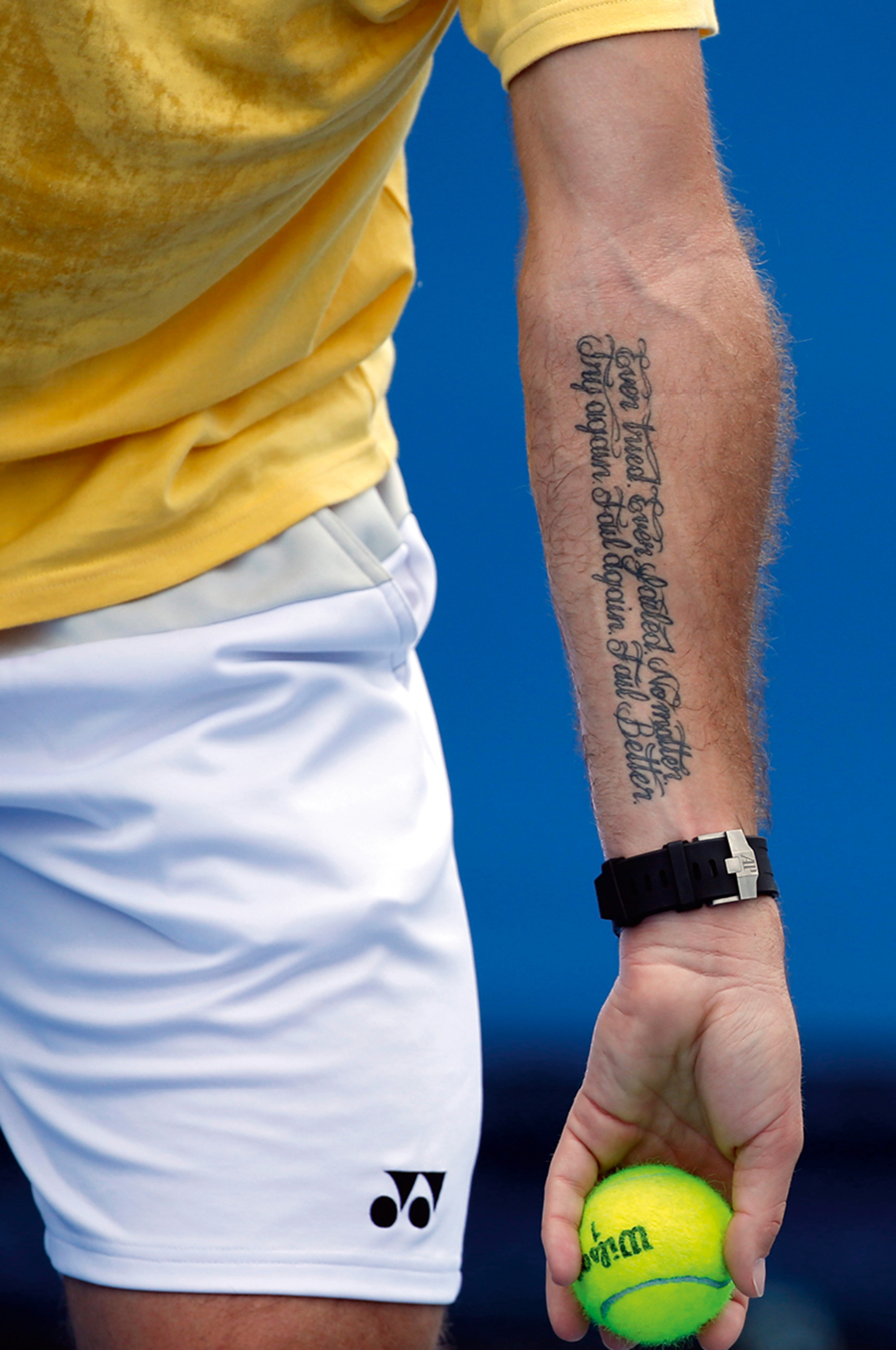
But the lines are only the beginning. Between every single point, he must also adjust a huge number of things, which are repeated in the same order between every single point in the match. They involve socks, headband, and underwear, front and back. He puts Zuma Rossdale to shame as concerns wedgies. TV coverage shows as little of this as it can, it being unusual for a grown man who knows he is being watched to touch his underwear as often as he does, and a little unseemly to emphasize it. But when you are right next to the court there is no missing it. I longed for the man in front of me yelling Vamos Rafa! during a second round match to turn and reveal himself to be Oliver Sacks so that he could walk me through the seeming pathology. But what is most astounding about this is not that an individual who chose, from an early age a life of competition under very stressful conditions has developed special mannerisms. What is remarkable is that he can turn them off as he does. I really like Nadal, so I say this without any hostility: if you watch him play, you assume he is unwell. And then after the match is over, he will leave that unfathomably exacting and superstitious place, and will be standing on court—right on one of the sidelines!—being interviewed and all of the tics and strangeness are gone, and we are in the presence of a very generous and deeply sane person.
By any global metric, the confidence exhibited by Federer or Djokovic or even the more mercurial Murray is unbreakable. But compared to Nadal’s otherworldly state, they are fragile. The problem that Federer and all others face against Nadal is that his will isn’t something they can envision breaking, because it doesn’t look like a will they know. The match that was widely considered to have been the greatest ever before being dethroned by the 2008 Wimbledon was a different Wimbledon final—one between McEnroe and Borg in 1980. Borg lost the fourth-set tiebreaker 16–18. McEnroe recounts looking for Borg’s gaze right at the moment of winning that epic tiebreaker, seeking to feed on his opponent’s discouragement. Borg made no effort to hide his eyes and what McEnroe saw there terrified him. To judge by Borg’s face, there was no problem, no discouragement. All it meant was that there would be more tennis, which was fine, for he loved tennis. Borg won the fifth set 8–6.
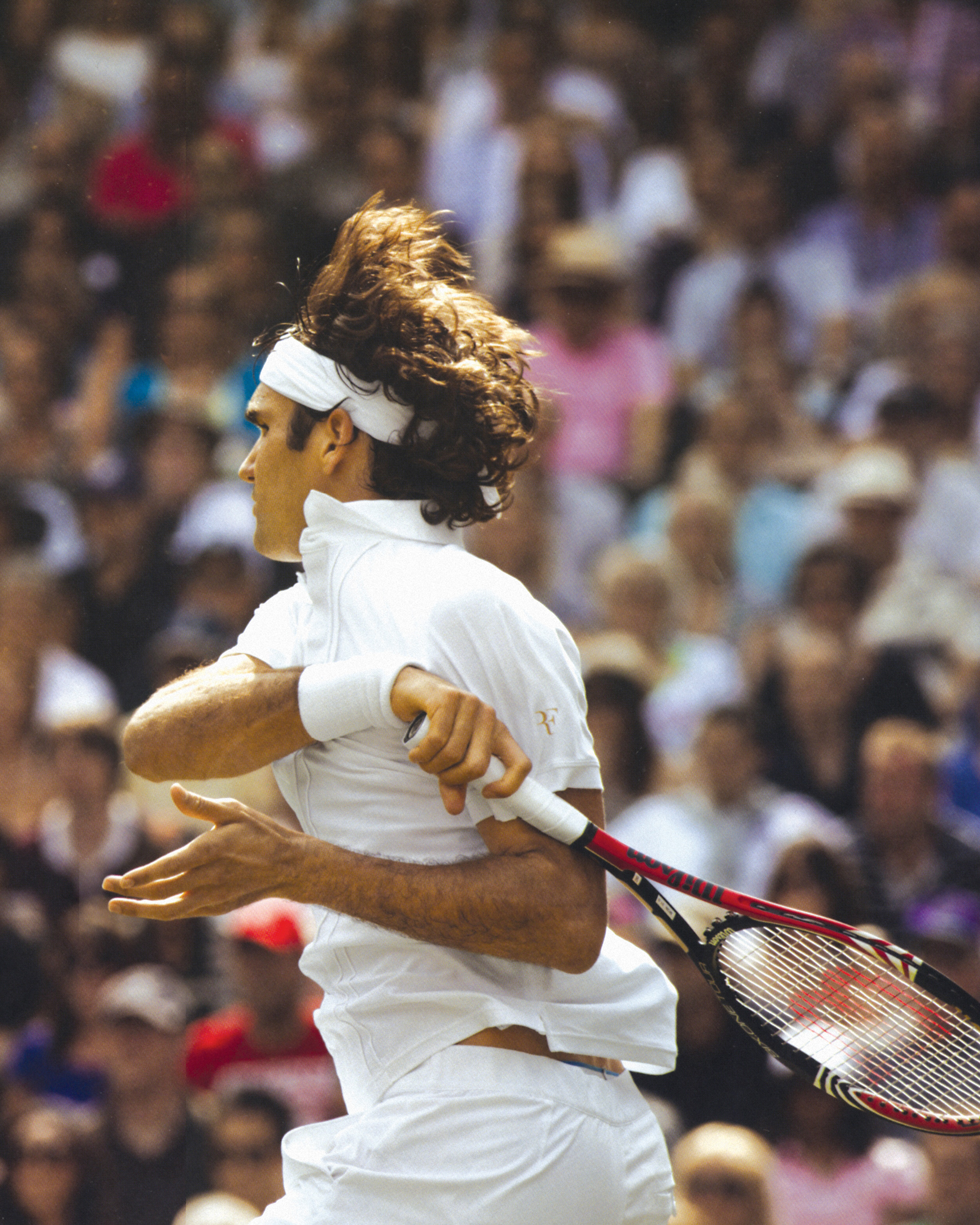
The day after my children’s crusade, Federer’s first-round opponent was asked, after losing in straight sets, if he was frustrated. This is a standard question to ask someone who has lost a lopsided contest, but it made no sense to young Devin Britton. He looked around the room in incomprehension, and said, gently but seriously, “No. Not at all.” A reporter pointed to the score. Unused to the ritual of the press conference, Britton explained that though he did not win very many games, he was very satisfied with his level of play. He did not say, “He was just better today,” which is the standard press conference phrase for such situations. He said, with respect and something that sounded like pride, “He’s Roger Federer.” Exactly as a young warrior on the windy plains of Troy might have explained having lost chariot and horses by saying, “He’s Achilles.” Another reporter asked him about his strategy. Britton replied that he tried to play toward Federer’s backhand, but not always. “His forehand is just crazy. It’s so pretty. I tried to keep it away, but sometimes I just hit it there just to see it.”
Federer is well liked by virtually everyone, especially by fellow players such as Nadal and Britton. Which, I concede, is a little boring when compared to the really quite vicious, but undeniably entertaining, outbursts of John McEnroe, the broadband emoting of Jimmy Connors, the absurd antics of Ilie Nastase, or the irreverence of Vitas Gerulaitis (at a press conference after having beaten Borg for the first time in seventeen tries, he declared: “No one beats Vitas Gerulaitis seventeen times in a row!”). Federer routinely does things that by any normal standard of human gratitude demand loud shouts of exultation in praise of the creator, and on which occasion he registers, at the absolute most, satisfaction. In his affect, he is not interesting to watch because he conceals his emotional state from his opponent, and consequently from the crowd. He is far less expressive than Nadal who, however obsessive with the bottles and the underwear, is an exciting fist-pumper and yeller of vamos. Federer makes a different claim on the viewer. He actualizes the greatest amount of tennis potential. He hits the widest variety of shots, explores the broadest array of angles and scenarios, attacking, prodding, feinting, springing, defending, inventive and calm at once, an Odysseus of tennis. (I know, he was Achilles a moment ago, but he’s that kind of a player.) I’ll stop there.
Leland de la Durantaye is professor in the Literature Department at Claremont McKenna College. His Beckett’s Art of Mismaking will be published by Harvard University Press in fall 2015.
Spotted an error? Email us at corrections at cabinetmagazine dot org.
If you’ve enjoyed the free articles that we offer on our site, please consider subscribing to our nonprofit magazine. You get twelve online issues and unlimited access to all our archives.